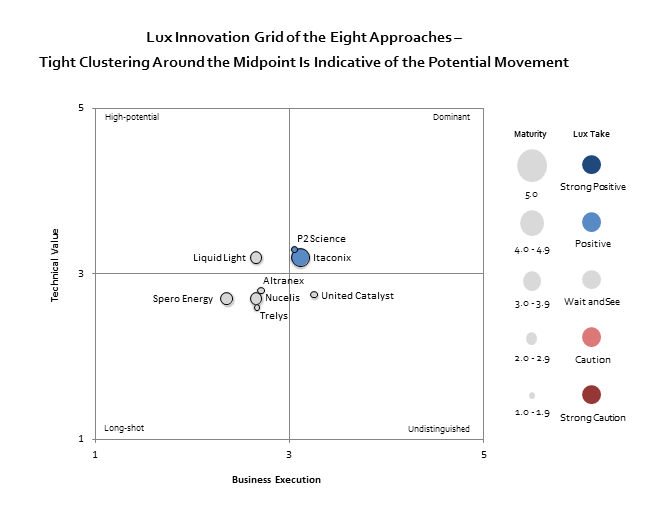Successful partnership strategy is a key ingredient for capitalizing on emerging technologies and bringing about transformative long term innovations. However, missteps when striking external relationships can be incredibly costly, draining both cash and precious resources. Perhaps nowhere is this double-edged sword dynamic more apparent than in the minefield of emerging technology start-ups, where statistics show that only 7% to 10% of such entities succeed, but the hidden gems that exist can be game-changing differentiators. However, data can make this process more predictable.
The Lux Research methodology of evaluating start-ups has been shown to identify and predict successful companies at rates as high as 50%. This assessment, “Measuring and Quantifying Success in Innovation”, also highlighted some of the underlying key factors that translated into measurably higher rates of success, including strong management team, momentum, barriers to growth, and partnership score, at 4x, 2.5x, 3x, and 2x, respectively.
But knowing which factors correlate with higher rates of success isn’t enough on its own, as an ever-changing competitive landscape and nuances of individual companies and markets needs to be accounted for as well. One way to apply the Lux methodology is to identify companies that may have underlying value, but aren’t already success stories. Specifically, we first screened for companies with average or below average (scores of 3 or less on a 1 to 5 scale) management team, partnership, momentum, and/or barriers-to-growth Scorecard values. From there we performed a critical review of how each of these companies plays in today’s environment, assessing for sustainable value proposition, current and future engagement opportunities, differentiation to enable market adoption, and opportunities to improve these Scorecard success indicators.
The bio-based materials and chemicals (BBMC) landscape is particularly ripe for employment of such a hunting for untapped innovation assessment. This space is increasingly crowded as groups continue to scale and put out commercial products. Add to that low natural gas and crude oil prices, and finding promising technologies and companies becomes increasingly difficult. Application of this methodology resulted in a list of eight innovative BBMC companies to watch for: Altranex (lubricants), Itaconix (polyitaconic acid), Liquid Light (MEG), Nucelis (squalene), P2 Science (azelaic acid), Spero Energy (DHE and DMPP), Trelys (amino acids), and United Catalyst (cellulosic biomass pretreatment). Analyzing these eight start-ups using the Lux Innovation Grid (see figure below) reveals tight clustering around the midpoint, indicative of the potential movement our “hunting” assessment was predicated upon. Specifically:
- P2 Science and Itaconix distinguish themselves by both sitting in the Dominant quadrant and by both having Positive takes. Both claim to have undisclosed collaboration/partnership arrangements, but additional product lines may still enable new engagement opportunities.
- Liquid Light is the lone High-potential company, while United Catalyst sits by itself in the Undistinguished quadrant. However, both need additional value chain partnerships to become more Dominant.
- Spero Energy, Altranex, Nucelis, and Trelys are Long-shots, though each needs something different to move towards the Dominant zone.
 Between product launches, mergers and acquisitions, and financial strain, the bio-based industry is going through a period of realignment, and consequently opening up opportunities to pick up IP and assets as start-up companies’ cash positions come under pressure. As clients evaluate their position and seek to capitalize on some of the most significant trends to watch in 2016 – including advances in biomass-to-sugar technology and an increasing focus on performance benefits vs. an undefined “greenness” factor – successfully applying such “hunting” methodology will be a critical tool for boosting standing in the space rather than risk losing ground to competitors moving more swiftly.
Between product launches, mergers and acquisitions, and financial strain, the bio-based industry is going through a period of realignment, and consequently opening up opportunities to pick up IP and assets as start-up companies’ cash positions come under pressure. As clients evaluate their position and seek to capitalize on some of the most significant trends to watch in 2016 – including advances in biomass-to-sugar technology and an increasing focus on performance benefits vs. an undefined “greenness” factor – successfully applying such “hunting” methodology will be a critical tool for boosting standing in the space rather than risk losing ground to competitors moving more swiftly.
Author
Ross Kozarsky
Source
Lux Research, press release, 2016-03-03.
Supplier
Altranex Corp.
Itaconix®
Liquid Light
Lux Research, Inc.
Nucelis Inc.
P2 Science
Purdue Research Park
Trelys, Inc.
United Catalyst
Share
Renewable Carbon News – Daily Newsletter
Subscribe to our daily email newsletter – the world's leading newsletter on renewable materials and chemicals









